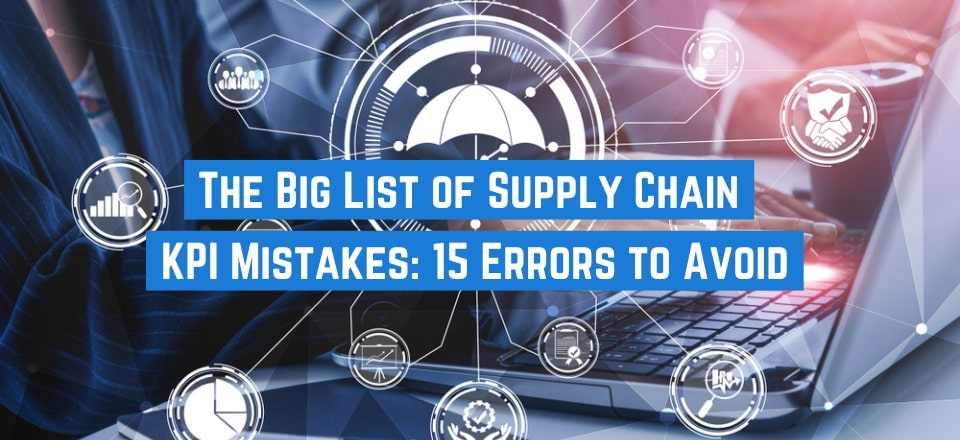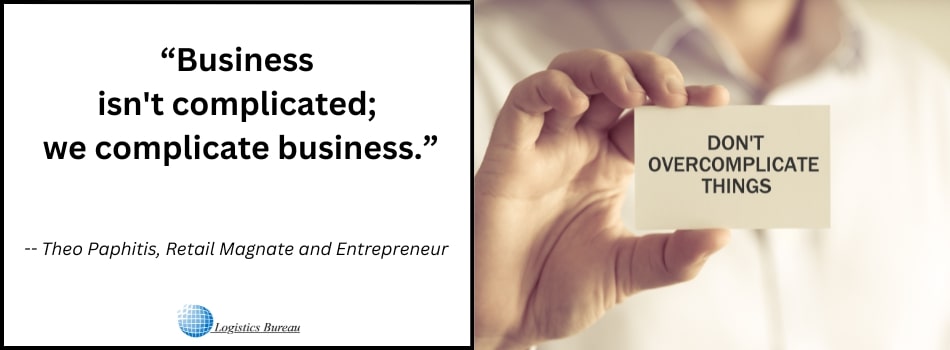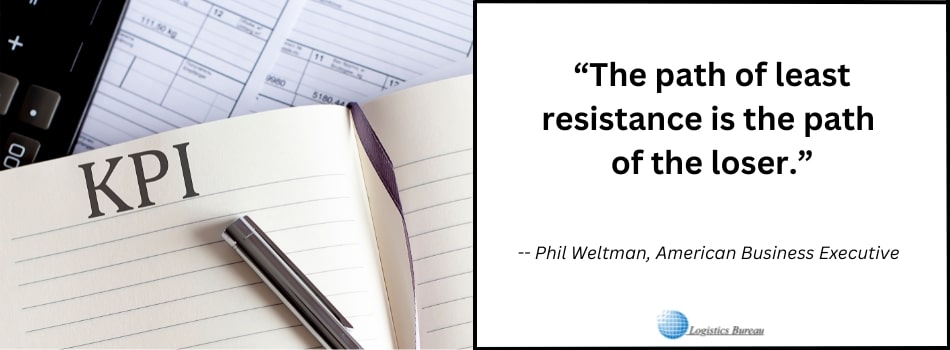Who would have thought that measuring the performance of supply chain processes like warehousing, procurement, or logistics could be so troublesome?
Well, we know a few supply chain managers who, having made some of the mistakes covered by this article, would attest to the potential for difficulty.
While technically, KPI selection and use are relatively straightforward, the mistakes we’ll discuss here can lead to many problems and difficulties. If you’ve experienced any of them, you may wonder, with good reason, if there is any real value in monitoring supply chain KPIs.
Perhaps more importantly, the impacts of some of these errors can mask the KPI’s involvement, leading managers on a wild goose chase looking for other causes. But we’re determined to enlighten you about their existence because, with that knowledge, you can avoid making KPI mistakes in your supply chain.
1: Neglecting to Use KPIs
It might seem logical to assume that if KPI monitoring is so unforgiving of mistakes, it’s better to dispense with them altogether, but that would be an unwise and incorrect conclusion.
Indeed, companies that track suitable KPIs and do so effectively will always enjoy better supply chain performance than those which don’t.
In our experience, though, companies that haven’t implemented KPIs are not without the will to do so. Instead, they are primarily unsure how to go about it, or their leaders have been preoccupied with other elements of supply chain operation and just haven’t gotten around to it.
Whatever the reason for neglecting to implement, maintain, track, and act on supply chain KPIs, it is a mistake you should avoid making. Without these critical metrics, you’re flying blind. You cannot determine how well or how poorly your supply chain processes are performing. Therefore, you can’t improve them.
2: Using KPIs That Are Not Aligned with Supply Chain Strategy
We’ve stated many times in our articles that a supply chain strategy can only succeed when aligned with the overall business strategy. In the same way that a misaligned strategy works against business success, so too do KPIs that are not aligned with the supply chain strategy.
The whole point of KPIs is to show you how effectively your strategy is working by indicating progress toward your strategic goals. Conversely, there is no point at all in gathering data that will not help you see that progress.
There are many possible reasons why companies make the mistake of using KPIs that don’t support strategy, some of which will be covered later in this article.
3: Using Overcomplicated KPIs
In our work with clients, we often come across KPIs that combine data from several sources and employ complex calculations. In most cases, that’s unnecessary and, at worst, confusing.
How do you know if a KPI is overcomplicated? Well, if you can’t explain it to a layperson within 20 seconds of dialogue, that’s a good indication.
Similarly, ask yourself if you can interpret a visual representation of the KPI in a chart instantaneously. If not, it’s too complex to serve your performance management needs.
However, a complex KPI may be the only appropriate solution in some circumstances. The only two such that we typically recommend are perfect order and delivery on time/in full (DIFOT).
As a rule, complexity is a risk in a KPI, increasing the chances of it being too sensitive or not sensitive enough and delivering misleading performance indications. Therefore, the most effective KPIs are usually the simplest.
4: Goal-setting Errors
The first of the mistakes listed that negatively impact the harmonious relationship between KPIs and the supply chain strategy, goal-setting errors are not KPI mistakes per se.
After all, some organisations, as mentioned previously, have no KPIs in use, even if they have formal goals for the business overall and the supply chain operation specifically. Therefore, the key for your business when implementing or reviewing its KPIs is to begin by checking the quality of any formally designated objectives.
Are your objectives SMART (specific, measurable, achievable, relevant, and time-bound)?
If they’re not, you might find it challenging to identify any KPI that will enable you to track progress toward them. Like your KPIs, the objectives that inform their purpose should be as simple and easy to understand as possible.
What Does a SMART Objective Look Like?
If you need an example to guide you in setting SMART goals for your supply chain operation, here is an overview of the right and wrong way to go about it.
For example, the following objective is not SMART:
Achieve the highest possible DIFOT percentage from all warehouses.
The above objective is not SMART, because:
- It is not specific unless you consider that 100% is the highest possible DIFOT percentage by default. And if the target is 100%, why not specify that for clarity?
- It’s questionable whether other stakeholders in your organisation would consider 100% an achievable DIFOT percentage.
- It’s not measurable, again, because there is no way to determine the highest possible DIFOT percentage.
On the other hand, the following goal is SMART:
Raise DIFOT performance to exceed 90% each month and maintain that performance throughout 2023/24.
The objective is SMART because it’s concrete and specific. Most importantly, from a KPI perspective, it’s measurable, as the team knows that the DIFOT KPI must be monitored and raised until it is consistently above 90%. It’s also time-bound since the statement specifies the period during which the KPI must continuously exceed 90%.
5: Monitoring Too Many KPIs
Many companies seem to fall into the trap of publishing too many KPIs—more than they can ever monitor effectively. Unfortunately, we see it all the time in our work with clients.
Do you feel your supply chain management team is tracking too many metrics? If so, it’s probably true, and what’s more, most of them are probably not KPIs at all (that’s why we said “metrics”).
Are You Sure All Your Indicators are KEY?
You should have a manageable number of metrics to track if you’re genuinely monitoring only key performance indicators. On the other hand, if your company maintains a long list of metrics, most of them are unlikely to be critical indicators. Instead, they are probably metrics you could dispense with and suffer no detrimental effects on performance visibility.
Indeed, our recommendation would be to consider reducing the number of metrics you track if they currently number more than 20.
You see, it’s not only the fact that many metrics add little value to performance tracking. It’s also about the reality that too many metrics can confuse your functional teams and prove demotivational. After all, it becomes a significant task to go through all those metrics and understand what they are telling you, let alone try to plan actions in response to the data.
6: Failing to Distinguish What Can be Measured from What Should be Measured
So this mistake is one that often leads companies to have too many KPIs. Of course, you can measure some of your supply chain processes with little effort, but does that mean you should have a KPI for all of them? And what about those processes that don’t lend themselves readily to performance monitoring?
In many cases, the things that are difficult to measure are also those for which a measure is most desirable. So avoid falling into this trap of taking the path of least resistance, measuring all the easy things while neglecting those performance elements that need more effort, skill, resources, or technology to measure.
Prioritise by Need, not Convenience
It’s imperative to prioritise your supply chain processes in terms of their need for performance measurement and, in doing so, to postpone consideration of the mechanics until you have a concrete list. Don’t measure something just because it’s easy, and don’t neglect to measure a process just because it’s not easy.
If you need help determining which measures and KPIs you need the most in your supply chain operation and prioritising them, that’s something that Logistics Bureau is always ready and willing to help you accomplish.
Please pay a visit to our benchmarking and KPI services page to learn more about how we can assist you with developing and implementing KPIs and using them to benchmark your supply chain.
7: Overreliance on Manual Data Processing
In this age of increased automation, it’s surprising how many companies still implement KPIs without any automated means to collect the necessary data, make calculations, and present the results for human consumption.
Instead, they rely on processes such as extracting data from an ERP system using a file download, placing that data into spreadsheets, and manually calculating the formulas to arrive at the metrics.
Besides being labour-intensive and inefficient, manual KPI collation is prone to human error, with potential issues ranging from data-entry mistakes to miscalculated formulae.
Then there is the need to give ownership of these KPIs to several people to ensure somebody is always available to generate the reports. It only takes one of the KPI owners to be less meticulous than the rest to create a situation where report accuracy becomes unreliable.
When manual KPI calculation results in errors that make metrics inaccurate and untrustworthy, it becomes challenging to make the right decisions in response to KPI fluctuations. Under such conditions, KPIs can become a performance liability rather than an aid to improvement.
8: Poor Communication of KPI Value/Benefits
The primary purpose of many KPIs will be to encourage behaviours within your workforce that lead to improved performance. Accordingly, those metrics, along with the associated goals, will be cascaded down through the relevant functions in your business.
However, rarely will the mere presence of a KPI drive any changes in behaviour or establish new behavioural norms. When people are unaware of how the KPIs impact supply chain performance and are ignorant of the value and benefits, they may see them as little more than additional layers of bureaucracy to complicate the working day.
For that reason, it’s a mistake to implement any KPI without clear communication relating to what insight it brings to the operation, how you expect people to act on those insights, and how the business will benefit from improving the KPI “score”.
9: Failing to Review KPIs Regularly
So you’ve invested a deal of time, money, and resources into implementing a magnificent set of KPIs to monitor performance in your supply chain. You may have completed the project without external assistance or engaged a supply chain consulting firm like ours that provides benchmarking and KPI services to assist you. What can possibly go wrong?
Well, plenty can go wrong if you make the mistake of thinking KPIs are for life. Supply chains always go through changes in dynamics as time goes by.
For that reason, several key performance indicators that prove ideal for your business today are likely to become less relevant in the future—and irrelevant KPIs are the enemy of successful performance monitoring.
To avoid falling into this trap and experiencing a gradual erosion of KPI benefits in your supply chain, we recommend you review your choice of primary metrics at least once, but preferably twice, each year. More often than not, your reviews will show that you don’t need to change anything, but you’ll be glad of your diligence the first time you spot the need for changes.
10: Making Too Many KPI Changes
While it’s a mistake to overlook the need for regular KPI reviews and changes when necessary, changing KPIs too frequently can also adversely affect performance monitoring efforts.
For one thing, it takes some time for people to work comfortably with a particular KPI and understand its insights, so if you change KPIs often, your managers and workforce may become disenchanted with continually needing to familiarise themselves with new metrics.
For another, it only makes sense to change KPIs if there is a compelling reason. We only recommend changing KPIs if it’s necessary for them to stay relevant to the goals of your business and supply chain.
Be especially wary of changing how you measure a particular process, such as bringing new elements into the calculation. Once you make such a change, you no longer have a relevant historical picture of performance, and are effectively beginning to track performance again from scratch.
If you must make such a change, we recommend maintaining the old version of the KPI, alongside the new one, for long enough to make a gradual and successful transition.
11: Failing to Consider How KPIs Affect Behaviour
We’ve already mentioned how KPIs often need to influence behaviours in your supply chain workforce. Yet it is a factor that business leaders often overlook—a counterproductive and sometimes potentially dangerous mistake.
To elaborate, assuming there is a human element to the process that you are monitoring, setting a KPI target WILL influence behaviour. If you haven’t prepared for that, it might affect behaviour in a way that can be negative for your operation overall, even while driving improvements in a specific performance element.
The Risks of Productivity KPIs
Productivity KPIs are a typical example of a KPI that can drive negative behaviours. For instance, if you set a target for units picked per hour in your warehouse, can you be sure that your staff won’t begin to take shortcuts and neglect good health and safety practices? Is there a risk that your operatives will make more errors by working faster to pick orders?
That’s not to imply that you shouldn’t have productivity KPIs, but rather to highlight the need for careful evaluation of the positive and negative effects each metric and associated performance target might have.
12: Following the KPI Herd
To return to something we stated earlier in this article, your supply chain KPIs should be closely linked and relevant to your business strategy. That’s why it’s not a good idea to blindly follow whatever performance measurements are currently favoured by industry pundits or are popular with your competitors.
Your KPI portfolio should be appropriate for how you operate your supply chain. Therefore, while some standard metrics will undoubtedly be apt, you should be bold enough to create unique KPIs that address specific performance concerns in your operations.
It’s Okay to Use Standard KPIs for Benchmarking
One exception to the “don’t follow the herd” rule applies when you set KPIs to benchmark your supply chain against others with a similar profile. Since you will be pitting your performance against your peers, you’ll need to track the same KPIs those companies use.
Our supply chain benchmarking services include access for clients to a vast KPI database populated with current results from many companies that choose to collaborate with us. As a result, we can help you to determine the best KPIs to use for benchmarking, depending on your supply chain profile.
Once you have completed a benchmarking project, you will have an accurate picture of your primary supply chain strengths and weaknesses. You can then implement specific KPIs tailored to your performance improvement needs.
13: Comparing KPI Results With Competitors
Benchmarking is a mechanism to compare KPI results for your supply chain with those of other companies. It’s a great idea, but not an easy process because you need access to other companies’ performance data, and naturally, that access is challenging to obtain.
Not only that, but some service providers that promise to help you benchmark your supply chain will recommend that you measure performance against your competitors—which is never a good idea.
Consider benchmarking against your competitors only if you know their supply chain profile is similar to yours. Just because you sell the same categories of products, it doesn’t automatically follow that your supply chain operates in the same way, at the same scale, and with similar resources and partners.
Focus on Peers With Supply Chains Like Yours
Aside from the likelihood of delivering inaccurate benchmarks, comparing your supply chain with your competitors will not necessarily help you get ahead of them. Aspiring to the performance achievements of your top-performing competitor will only help you to become second-best.
On the other hand, by picking companies with closely matching supply chain profiles, benchmarking will show you the possibilities for stretching your operation to become the best it can be, without encouraging you to be a follower of your top-performing competitor.
14: Omitting Ownership
We have found that when clients ask us for help with their logistics KPIs, it’s common for our initial investigations to uncover a need to improve clarity within and across supply chain functions relating to ownership and accountability. Ignoring that need would be a mistake because, without ownership, KPIs have little value.
Ownership of each KPI must be clarified at the functional and individual levels. Okay, so perhaps it’s obvious that picking accuracy is a warehouse metric, but who should be responsible for a less self-evident KPI, such as dispatched on time?
Is it the warehouse manager, or the transport management team? If it’s not clear which one it is, then the reality is that nobody is responsible. In such a case, the KPI might as well not exist at all.
If you want to use KPIs successfully to improve supply chain performance, make sure that every function has ownership of specific metrics, and that somebody in that function is accountable for acting on the information the KPIs provide. And, of course, that means the owner should be somebody with the power to make decisions and implement changes.
15: Not Following Information with Action
A well-chosen set of KPIs will give you an accurate and clear picture of supply chain performance—but nothing more.
KPIs will not improve your business, but actions will. So why do so many companies invest time, money, and resources in KPI implementation and then fail to act on the picture they provide?
That’s one of the reasons why we mentioned the importance of KPI ownership. A lack of action often arises from a lack of ownership. However, there may be other reasons to explain why your teams are not acting on KPI results.
What’s with the Lack of Action?
If you’re not seeing all your KPIs trending in the right direction within a few months of implementation, it will be time to discover what’s stopping people from taking the appropriate actions. Typical reasons might be:
- Confusion over KPI ownership and accountability
- A lack of understanding of what some KPIs are indicating, due to poor communication
- KPI owners who are not empowered to take the necessary actions
- Too many KPIs (Paralysis by analysis)
Whatever the reasons, this KPI mistake should be rectified at the earliest opportunity. On their own, KPIs are only information sources, and it’s not enough to merely notice what they reveal. It’s the actions that arise from them that give KPIs their value.
That fact makes this a fitting finale to our big list of supply chain KPI mistakes because the consequences of this last entry are the same as those of the first mistake on the list, not having KPIs at all.
Make No Mistake, A Little KPI Help Goes a Long Way
Now that you’re aware of some common KPI mistakes to avoid, perhaps you’ve found that your company has already made some of them and needs to make some changes and improvements. Or maybe you haven’t yet implemented supply chain KPIs meaningfully and feel it’s time to do so. After all, it’s never too late.
In any case, Logistics Bureau is here to help with KPI problem-solving, selection of metrics, implementation, and supply chain benchmarking. Our KPI database is vast, continually updated, and full of data from companies with supply chains just like yours.
To learn more about how we can help you avoid KPI mistakes and get more from your supply chain metrics, visit our supply chain KPI and benchmarking service page now.
Editor’s Note: The content of this post was originally published on Logistics Bureau’s website dated February 07, 2023, under the title “The Big List of Supply Chain KPI Mistakes to Avoid“.












